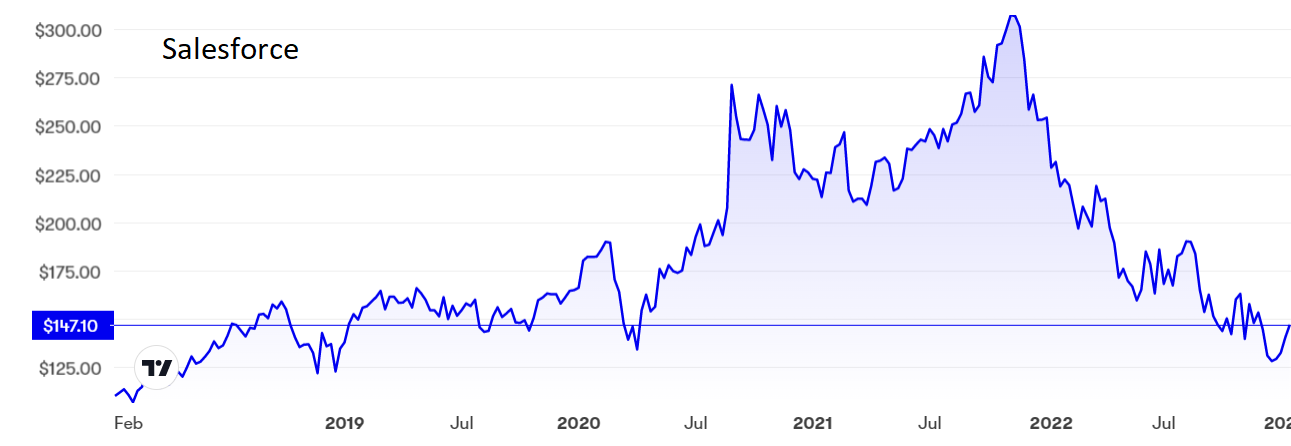This former hot stock is ready to rise again
11th January 2023 09:27
by Rodney Hobson from interactive investor
Worth half what it was at the end of 2021, this $150 billion business is on the rise again and could offer the prospect of short-term profits, believes overseas investing expert Rodney Hobson.

American tech companies are laying off staff. Investors need to decide if this is a continuation of the declines seen in 2022 or a sign of greater realism at the start of 2023.
One example is cloud-based software group Salesforce Inc (NYSE:CRM), which helps companies with customer relations management by connecting customer data across computer systems, apps and mobile devices. It is a clear leader in its niche market and success looked assured for a company supplying a product that was in increasing demand globally.
- Invest with ii: US Earnings Season | Buying US Shares in UK ISA | Cashback Offers
Now Salesforce says it has too many staff and too many offices at a time of slowing economic activity. One in 10 out of more than 70,000 employees face losing their jobs within weeks, and offices will be closed or reduced in size. Customers are taking “a more measured approach to their purchasing decisions” according to co-founder and chairman Marc Benioff.
In other words, persuading hard-up companies to upgrade existing technology is going to be pretty tough throughout this year. The war in Ukraine, soaring energy prices and disruptions to the supply chain caused by Covid chaos in China are not conducive to carrying out expensive technological updates.
If anything, Salesforce has been slow to face the reality of the situation. Meta Platforms Inc Class A (NASDAQ:META), Amazon.com Inc (NASDAQ:AMZN) and Uber Technologies Inc (NYSE:UBER) all moved to cut thousands of jobs last year. Indeed, online retailer Amazon is already embarking on a second wave of redundancies, adding a projected 8,000 sackings to the 10,000 indicated in November.
Benioff admits that enthusiasm in the good times overrode the need for realistic judgement. As revenue raced ahead during pandemic shutdowns, when companies were desperate to install systems that allowed staff to work from home, so too did staff numbers at Salesforce. The boss accepts responsibility, but it is the staff now surplus to requirements who will feel the pain.
Redundancies are inevitably expensive. From the company’s perspective, it is money down the drain. Some employees will receive five months’ salary.
Salesforce has other, unrelated problems. Bret Taylor, who has been joint chief executive alongside Benioff, has departed, alongside Stewart Butterfield, the boss of Slack Technologies, a digital platform for business communication that Salesforce bought for $27.7 billion in 2021. This was one of a number of bolt-on acquisitions that looked game-changing at the time but possibly over-ambitious now.

Source: interactive investor. Past performance is not a guide to future performance.
Unfortunately, the most recent quarterly figures for Salesforce only add to the confusion. While revenue grew an impressive 14% year-on-year to $7.83 billion in the three months to the end of October, net profit slumped to $210 million, less than half the $468 million earned in the equivalent quarter a year earlier.
However, that fall in earnings was more than accounted for by the fact that gains on investments had artificially boosted the previous year’s figures. Also, Salesforce spent more on research and development this time, a move that one hopes will help the company to maintain its leadership in its chosen field and increase future profits.
Salesforce actually raised its earnings per share forecast for the full year to the end of January from 40 cents to at least 55 cents.
- How my share tips performed in 2022 and what I’d do with them now
- 11 ways to invest your ISA like Warren Buffett
The less gung-ho outlook has been factored into the Salesforce share price. From a peak of just over $300 only 14 months ago, the stock has tumbled along with the tech sector generally to a low below $130 in mid-December. This has been a support level in the past and it looks to be the bottom once again. The shares have already ticked up to near $150 and look set to climb further.
Hobson’s choice: There is no dividend and the price/earnings ratio is in the stratosphere at 566 so this is not a stock for income seekers or the faint-hearted. However, this is a potential buy for shorter-term investors. If you are tempted, consider taking profits above $180 as the shares could well go into reverse anywhere near $200.
Rodney Hobson is a freelance contributor and not a direct employee of interactive investor.
These articles are provided for information purposes only. Occasionally, an opinion about whether to buy or sell a specific investment may be provided by third parties. The content is not intended to be a personal recommendation to buy or sell any financial instrument or product, or to adopt any investment strategy as it is not provided based on an assessment of your investing knowledge and experience, your financial situation or your investment objectives. The value of your investments, and the income derived from them, may go down as well as up. You may not get back all the money that you invest. The investments referred to in this article may not be suitable for all investors, and if in doubt, an investor should seek advice from a qualified investment adviser.
Full performance can be found on the company or index summary page on the interactive investor website. Simply click on the company's or index name highlighted in the article.
Disclosure
We use a combination of fundamental and technical analysis in forming our view as to the valuation and prospects of an investment. Where relevant we have set out those particular matters we think are important in the above article, but further detail can be found here.
Please note that our article on this investment should not be considered to be a regular publication.
Details of all recommendations issued by ii during the previous 12-month period can be found here.
ii adheres to a strict code of conduct. Contributors may hold shares or have other interests in companies included in these portfolios, which could create a conflict of interests. Contributors intending to write about any financial instruments in which they have an interest are required to disclose such interest to ii and in the article itself. ii will at all times consider whether such interest impairs the objectivity of the recommendation.
In addition, individuals involved in the production of investment articles are subject to a personal account dealing restriction, which prevents them from placing a transaction in the specified instrument(s) for a period before and for five working days after such publication. This is to avoid personal interests conflicting with the interests of the recipients of those investment articles.